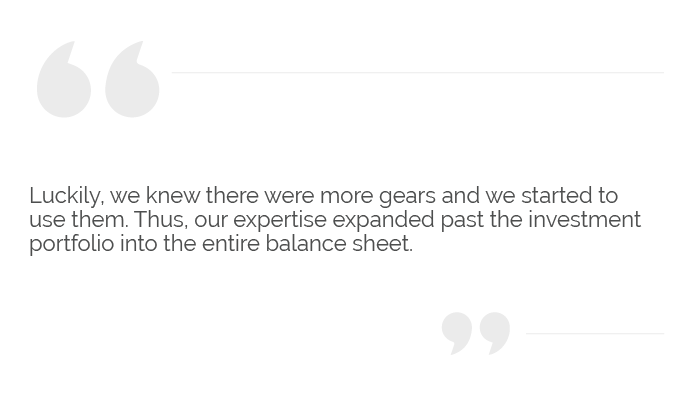Today, I'm going with a strange theme: Charlie Brown. Well,
it's not exactly Charlie Brown, but really a theme from his creator, Charles
Schulz. Schulz once famously said, "Life is like a ten-speed bicycle. Most of
us have gears we never use." This has really struck a chord with me lately because I have only recently discovered my gear for writing (although many will
say it is a rough gear indeed!).At
Performance Trust, we have also discovered our extra gears and I have to tell
you, it has been transformative.
Let's take a step back for a minute.
As you know from previous posts, it is my long-standing
belief that while investing is definitely not an easy discipline, it can be both
rewarding and challenging. The thing that has always excited me about fixed
income investing (vs. equities) is that you can use your brain to be better at
it than others.It isn't just catching
that lucky stock. There is actually a framework—and skill—involved in being a
great fixed-income investor. If you work hard at it and care about performance,
you can excel. If you are lazy or just don't really care, you will
underperform. It's as simple as that. I've always felt like the equity crew
gets all the limelight, but there is a tremendous amount of guessing and luck
that goes into stocks. Were you long TSLA this year? If so, you outperformed
even though the stock you own is trading at a preposterous multiple (currently
over 948)!
The way we frame the fixed income paradigm is really helpful.
I have discussed this before, but I think it is worth repeating: TMI. Time, money,
interest scenarios. One of the wonderful things about fixed income investing is
that there is a definite time component. Except in extreme conditions, you will
rarely see a fixed income security change by 10% in a day whereas it happens
all the time in equities. Additionally, most fixed income portfolio managers
are not day traders. We are buying bonds and securities for our portfolio to
hold over extended periods of time. We think in terms of years, not seconds,
minutes, hours, or even days. That is the reason why it is so critical to
include time in our investment decision making rationale. Unfortunately, our
industry generally relies on two main metrics for decision making: yield and duration.
Neither of these metrics include time in their calculation. This is very
unfortunate. The word "duration" connotes the idea of time but is actually a
very short-term metric that is attempting to calculate price volatility. Sadly,
it is often way off the mark, even for this purpose. Similarly, yield is a very
short-sighted and flawed metric that attempts—poorly—to figure out what we
really want to know, which is how much will we earn from our security. The more
complicated the security, the more inaccurate yield becomes.
These statements may come across as kind of harsh…but they
are accurate.
So, after time comes money. Virtually all fixed income
portfolio managers work for an institution of some sort. We have someone we
need to report our results to, whether it be a board, a committee, shareholders, or owners. Ask yourself the question, what do these people really want to know?
Think about the monthly, quarterly, or annual meeting where you need to report
your results. What numbers do they look at when you plop down that huge
portfolio report? Most (if not all) of them have no clue about fixed income portfolios
(there are exceptions, of course). Their eyes will take them to the numbers
they have all been told are important—yield and duration. But we just uncovered,
those numbers are actually not very helpful. By the way, they will also notice
if there is suddenly a large loss! But what they really want to know though is how
much money they are making. Money is the universal language that anyone in
their position understands. Month to month, quarter to quarter, year to year. How
much more money do they have than before? It's actually so much simpler when
you remove the jargon.
Finally, I want to discuss the I—interest rate scenarios. In
a funny twist of fate, neither of the aforementioned stats, yield and duration,
even consider interest rate scenarios. This is one of the few things we
actually do know about the future; namely, that interest rates will change. As hectic
as 2020 has been, it won't change the inevitability of change. The major things
we don't know are in which direction interest rates will go, and how far. Obviously,
these are pretty important factors to consider when making an investment
decision. So, what is the best way to handle this conundrum? Analyze multiple
scenarios. And this is where the real power of TMI comes into play. In the
past, I have mentioned one of my favorite quotes by Lao Tzu, a 5th Century
BCE Chinese philosopher, who said: "Those with knowledge don't predict and
those that predict don't have knowledge". So, accept it. We just don't know. We
incorporate both a variety of time and interest rate scenarios into all of our
analysis and then simply count the money in each combo and compare them.
Do that work, lay it out logically, and your reporting body
will understand it.

Now, let's get back to this Charles Schulz quote for a
minute. I think it's pretty self-explanatory: We all have gears that we don't
(and in some cases, don't know how to) use. This became evident to the company
I've had the pleasure of working for the past 25 years, most of my adult life.
We were very good at using the one or two gears. This expertise was in the fixed
income arena. We followed the principles above (TMI) and through hard work and
determination, became very good at helping fixed income investors achieve
results that might have been unattainable had they remained stuck in the yield/duration
paradigm. But we never really tested the other gears on the bike. This allowed
us to dominate in certain areas, but then be left behind if we had to switch
gears into things like balance sheet management, risk measurement, capital
structuring, and the like. Let me assure you, you will never win the Tour De
France if you only use one or two gears on your bike. As a side note, I
understand that for one stage this year, not only did riders switch gears but many
of them also actually switched bikes for an exceptionally difficult stretch!
For more on that, look into this year's Tour De France.
Luckily, we knew there were more gears and we started to use
them. Thus, our expertise expanded past the investment portfolio into the
entire balance sheet. To help me demonstrate this further, over the next couple
of weeks, I am inviting experts on a variety of topics to discuss different
aspects of the balance sheet here on the blog. I hope you join me for the ride
(see what I did there?).

Final, final thought: Having spent a couple of nights in the hospital this past week, I can now definitively declare that beef broth and
Lime Jell-O are not a recommended flavor pairing.
Be sure to fill out the form below to subscribe to my weekly blog


